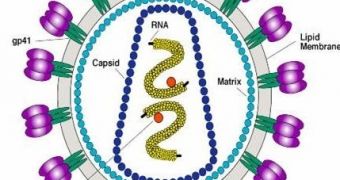There may be nothing religious on the way HIV transmits itself, but HIV-positive people who pay attention to religion are less likely to transmit the virus than other HIV patients.
The RAND Corporation research assessed religiosity of the subjects, assigned them to a particular religious group, if they preferred spending time with people of the same religion and how often they attended religious services on a sample of 1,421 HIV patients, 932 of whom were sexually active.
"The study did not identify what specific component of religiosity made a difference in sexual activity. However, two factors - moral beliefs and membership in a faith community - may be important." said David Kanouse, a RAND senior behavioral scientist and principal investigator on the project.
"Moral beliefs may indicate an underlying altruism and a desire to make sure no one else is infected with HIV. Promoting these feelings could then be used as a component of HIV prevention programs." said Kanouse.
"These are some significant findings about the role of religiosity in the lives of people who are HIV-positive," said Frank H. Galvan, lead author of the study and assistant professor in the Department of Psychiatry and Human Behavior with the Charles R. Drew University of Medicine and Science in Los Angeles.
"The next step is to find out how can we use this information in a way that can help lower the rate of spreading HIV to others. Religion remains a dominant force in America today, but the main focus of many faith communities is sexual abstinence, rather than examining how else religious beliefs may help to prevent the spread of HIV," said Galvan.
"This study suggests that there's a role for religious institutions to play in the fight against the spread of HIV. They have these core belief systems that do have a positive impact on the lives of people who are HIV-positive and who are sexually active. Religiosity is an untapped resource in the whole struggle against HIV and AIDs, and should be looked at more thoroughly." he added.
Catholics and Evangelicals were less likely to practice unprotected sex and had fewer partners than the other categories. The new research employed data from the HIV Cost and Services Utilization Study (HSCUS), led by RAND from January 1996 to April 1997.
The sample compassed a national probability random to race or gender.
"The RAND study's findings are not likely to have changed over time. The findings are consistent with other studies that have found a link between religiosity and fewer lifetime sexual partners and an inverse relationship between religiosity and other high-risk behaviors, such as substance abuse." said Galvan.
Other investigations pointed that homosexual men attended religious services at a similar rate to heterosexual men.
The subjects were assigned into the next categories: Catholic, Evangelical, Other Christian, Non-Christian Religion, and No Religion/Agnostic/Atheist.
The greatest part of the subjects were nonreligious and Evangelical.
African-Americans made up about 30 % of the survey population, even if they form just 13 % of the U.S. Population, and most of them belonged to Evangelical churches.
One factor influencing the high number of non-religious respondents is that many religious groups regard homosexuality to be a morally unacceptable lifestyle, while homosexual and bisexual men formed over 50 % of the study sample.
The results were somewhat enigmatic, like the percentage of Catholics more likely to employ condoms despite the Catholic Church's prohibition on birth control.
Perhaps the sources each denomination looks for on taking a moral decision bias the final result: some Christian denominations rely only on the Bible, while others permit additional guidance from other sources, like traditions or personal conscience.
"Although the Pope may issue a proclamation on some aspect of sexual behavior, Catholics increasingly are inclined to consider their individual consciences as sources of moral authority. What role this may play in the sexual behaviors of Catholics and how this may differ from other religious groups warrants further investigation."

 14 DAY TRIAL //
14 DAY TRIAL //